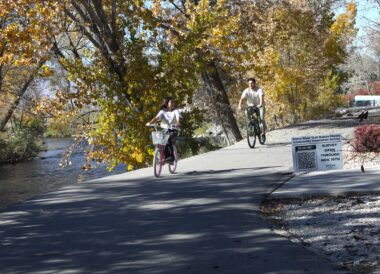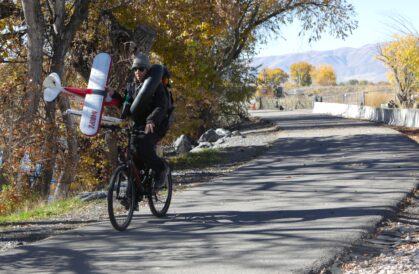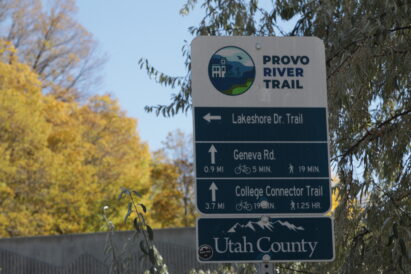A web of recreation: The Utah Trail Network master plan aims to connect the state – including Utah Valley
- A girl and a man ride their bikes down the Provo River Trail Sunday, Nov. 2, 2025, in Provo.
- A man rides his bike down the Provo River Trail Sunday, Nov. 2, 2025, in Provo.
- A Provo River Trail sign is shown Sunday, Nov. 2, 2025, in Provo.
Future generations of Utahns may enjoy a state where paved trails aren’t just recreation destinations that require traversing highly trafficked roadways to access, but a web of trails easily accessible from your front door.
The Utah Department of Transportation released the Utah Trail Network master plan last week, rolling out a proposal that includes 2,600 miles of new paved trails and 500 miles of existing trails to connect 208 towns and cities across the state.
As part of the proposal, 95% of Utahns would live within one mile of the Utah Trail Network.
“We need to spend more time outside, more time connecting with people and more time exercising, and the way we do that is through our trail system,” Gov. Spencer Cox said in an announcement. “The Utah Trail Network helps every Utahn commute, recreate and enjoy Utah. It’s a great way to build for future generations.”
In 2023, the state legislature allocated $45 million in annual ongoing funding to UDOT to plan, design and construct a network of paved trails.
Stephanie Tomlin, the director of the Utah Trail Network at UDOT, said using this ongoing funding — which has no sunset — allows UDOT to build out these trails for years to come, and that the master plan provides the blueprint to follow.
“What this represents is a really exciting, ambitious plan, because it’s comprehensive and vast in terms of mileage, and it’s connecting many parts of the state,” Tomlin said. “This is kind of the guiding light, so to speak, of where UDOT will be going.”
Tomlin compared the master plan to UDOT’s existing road system, with interstates and state highways connecting the state.
In Utah County, the plan includes several existing trails that extend for miles, including the Jordan River Trail, Murdock Canal Trail and Provo River Parkway Trail, as well as trail proposals such as the extension of the Utah Lakeshore Trail and the Springville 1200 West Trail.
In conversations with local stakeholders, UDOT heard about the importance of the Utah Lakeshore Trail and the Highline Canal Trail in southern Utah County and ensured both are in the future plans, according to Tomlin.
“A part of our master plan effort was to look at existing trails that are already serving that regional purpose and see where we need to link them up with proposed trails,” she said.
There are also “gap closure” trails, which do not have existing planned routes but are necessary to link existing and proposed trails together. Gap closure trails are proposed in Orem, Provo and Spanish Fork; however, their exact locations aren’t identified because feasibility studies are still needed, Tomlin said.
The most ambitious mapped-out trails are “proposed vision corridor” trails — newly proposed routes such as the 25.3-mile U.S. 6 Spanish Fork-to-Helper Trail, the 21-mile SR-73 Fairfield-to-Stockton Trail and the 9.7-mile Santaquin-to-Mona Trail.
Tomlin said visionary routes aren’t guaranteed due to their length and geographic restrictions and will require extensive studies. If feasible, she said, they are costly projects that may require supplementing costs with grant opportunities.
“The visionary projects — this is really pie in the sky — but it’s important in master planning work to really think and dream big, and put your moon shots out there, and that’s why you’re seeing them on the map,” she said.
All the proposed trails would also require working with local municipalities and stakeholders. In urban areas, particularly on the Wasatch Front, Tomlin said the projects are more feasible because of existing trail infrastructure.
“It’s really a testament to the work that many stakeholders, entities and communities have already done in this space, and I think what UDOT is trying to do here is pick up the mantle and make sure that everything connects together,” she said.







